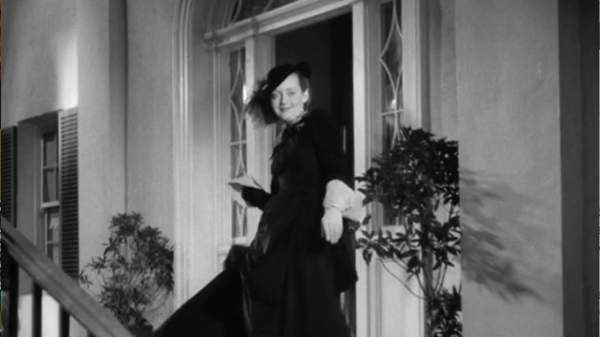
JEZEBEL (1938, Wyler)
Today’s post has as much to do with David Fincher as it does with one of my all time favorite directors, William “Willy” Wyler, who’s known for, among other things, the beautifully natural performances in his films. What do these two directors have in common? A propensity for an unusually high number of takes.
Fincher is notoriously known, like Kubrick, too, for racking up close to 100 takes on any given shot that has any real drama or character moment in it. The opening scene in The Social Network is already famous for its 99 takes.
So what’s ol’ Willy doing here… Well, I stumbled upon this great excerpt from his biography A Talent for Trouble, about his first working experience with Bette Davis. Like Davis, I’d been leery about so high a take count (as was 1-take-and-we’re-out John Ford), mostly because my budgets haven’t allowed more than say 8 takes max, but also because I was incredulous about what was really gained. In my experience, I had found that most actors are kinda generally at their best in one of the following three “take zones.”
Gets it on the –
– First Take (sharp actor has it all worked out, but not much change thereafter)
– Second & Third Take (get the jitters out, good a few takes, but thereafter it gets staler)
– Eighth Take (they finally get the words down, figure out the vibe and can run with it)
Part of the fun, I find, is figuring out where your actors hit it, and then arranging your coverage to coincide. In Martha Coolidge’s wonderful commentary on Rambling Rose, she talks about working her coverage schedule in support of Robert DuVall, Laura Dern and Diane Lane. Great case study.
So the 8-10 takes works very well when you’re on a tight budget and schedule. But Fincher operates (as did Wyler) with a bit more slack in his schedule and he speaks of the magical benefits of the transformation in performance that seems to happen around the 40th take. I would guess it’s a case of the actor’s exhaustion allowing them to completely let go of the part of their brain that’s trying to control it. So when I happened upon this excerpt of Wyler’s experience, I had a bit of a “eureka!” understanding of this crazy amount of takes technique, which I’m sure my producer is overjoyed to hear.
Here’s the excerpt from Wyler’s biography (which I highly recommend) and the clip they speak of. You really can see an undefinable spark in the take he used. What I wouldn’t give to see the 47 takes that preceded it!
William Wyler according to Bette Davis
“The first day on Jezebel he made me do forty-eight takes,” Davis recalled. “I never in my life had done more than 2 takes, ever.”
The scene required Davis to dismount from a horse and rush into a formal gathering. Wyler had invented an inspired bit of business to complement Julie Marsden’s cavalier character. He wanted Julie, who is arriving late for her own engagement party, to hike up the long train of her riding dress with a riding crop and in, a rather unladylike gesture, hook it over her shoulder as she strides into the house.
Wyler had told her to practice with the riding crop before shooting began. The gesture had become second nature to her, and she felt she’d got it right on the first take. But Wyler apparently didn’t think so. He asked for another take, then another. After a dozen more, Davis was exasperated and confused.
“What do you want me to do differently?” she asked him.
“I’ll know it when I see it,” Wyler said.
Thirty-three takes later, without so much as a thank you, he commented, “Okay, that’s fine,” and called an end to the day’s filming.
Furious, Davis demanded to see the takes. Wyler obliged by screening them for her that night. They were a revelation. What she thought she had done exactly the same proved to be different each time. The early takes looked practiced. The later takes not only looked more natural but showed that when she had felt irritable and fatigued she seemed vigorous and excitable. And that was precisely what the scene required.
In conclusion, my minds a bit more open to what may happen to an actor’s performance upwards of 40 takes. I mean, Wyler and Fincher are no slouches.
Finally, please forgive the racial stereotypes that blight this film from 1938 (which doesn’t make my list of top Wyler films) and are present in this clip.
The shot in question is at :21 – remember, it’s take 48!

Adriana
This is fascinating.
jsbfilm
I felt so, too! Thx for comment, A.
Pingback: MIDNIGHT SUN (2011, Baumgartner) « shot4shot
dave c
A similar thing can happen on stage. If an actor is getting tired or irritated he/she can suddenly hit upon a new level of energy/sparkle. . . but – like you said – you gotta know your actors! Some won’t/can’t be pushed like that.
jsbfilm
I never would have thought of that, what with their being only “one take,” in theater, but the whole rehearsal process must offer countless opportunities to improve an actor’s performance through such torture!
Pingback: FUNNY GIRL (1968, Wyler) « shot4shot
Mary
Very interesting .. I had never seen the point behind doing that many takes before. Great post John!
jsbfilm
Thanks, Mary! It was such a revelation for me to finally have a concrete example of what the technique was providing. Thanks for reading and commenting on here, FB and Twitter, Mary!
Tyler Poppe (@tylerpoppe)
This and the Kubrick posting are my favorite.